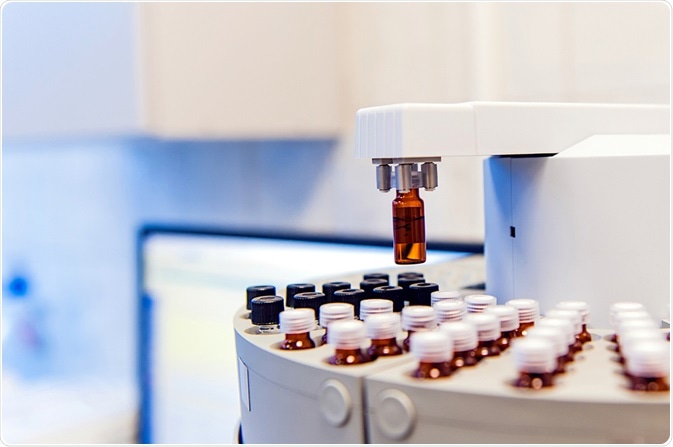Chromatography is a widely used analytical technique with a range of applications. However, the process is associated with the use of harsh chemicals which can damage the environment and put those working with the method at risk of exposure to dangerous materials.
 Image Credit: borzywoj / Shutterstock.com
Image Credit: borzywoj / Shutterstock.com
For this reason, recent advancements in chromatography have focussed on cleaning up the process and making it more eco-friendly in order to prevent pollution.
The Extensive Use of Chromatography
Chromatography is the process of separating a mixture of chemical substances, pulling out the individual components that make up the mixture to be thoroughly analyzed. The technique is relied upon by many fields of science, including the food science industry, where chromatography is used to detect additives in food and determine the nutritional profile of food products.
Forensic science also frequently uses chromatography to test samples taken from crime scenes, as well as in tests of forensic pathology and arson investigation. The pharmaceutical industry also makes use of chromatography in the vaccination development process as well as in drug testing.
Additionally, techniques that combine electrochemistry (EC) and MS (mass spectrometry) with chromatography are used to instigate redox reactions in bioorganic molecules. The fields of metabolomics and proteomics, as well as research into nucleic acids rely on these newer hybrid methods.
Given the numerous applications of chromatography across various fields of science, it is important to consider and control for its negative impact on the environment and users of the method.
Making Chromatography “Greener”
There is a strong movement to reduce or, if possible, eliminate the use of hazardous solvents in scientific protocols. Green analytical chemistry (GAC) is the term given to this concept which is widely recognized around the globe.
Through considering the environmental impact of all stages of analytical procedures, GAC aims to develop new “greener” methods that have a significantly reduced impact on the environment as well as minimal implications for those working with analytical techniques.
The concept of GAC has already been successful in encouraging significant “green” developments in analytical techniques, resulting in the establishment of microextraction, microwave-assisted extraction (MAE) techniques, and ultrasound-assisted extraction (UAE). Currently, there is a strong focus on developing chromatography techniques, innovating new methodologies that do not rely on toxic solvents.
This movement towards a more eco-friendly method of chromatography, while it has considered all steps of analysis, has focussed on updating the most environmentally damaging steps of the methodology.
Sample preparation and chromatographic separation are considered to be the most environmentally damaging, offering researchers a window of opportunity to make chromatography much “greener” by updating these steps. Below, we discuss the recent developments in these particular areas.
Updating Sample Preparation
The sample preparation stage of chromatography is considered to be the most environmentally damaging step. Scientists aiming to make chromatography more eco-friendly stress that the necessity of this step should always be considered. However, in most cases, sample preparation is vital.
Therefore, new chromatographic procedures have been developed that reduce the environmental impact of the method. For example, approaches that use simple matrices including water, alcoholic beverages, and petroleum products instead of harsh chemicals have been developed to replace the previously environmentally detrimental method in certain scenarios.
One non-solvent sample preparation technique that has gained much interest in recent years is that of dispersive liquid-liquid microextraction (DLLME). DLLME uses a very small amount (below 100 µL) of a nonpolar solvent combined with around 1 mL of less toxic dispersive solvent.
Extractions using this method can be assisted with ultrasounds that are used to eliminate the need for a disperser solvent. Solidification of floating organic drop (SFO) has been developed as an alternative to DLLME.
This method uses alcohols including nonanol, decanol, or undecanol as extraction solvents. The SFO does not require the sample to be exposed to such high temperatures, reducing its environmental impact.
Updating the Separation Process
Liquid chromatography is generally less “green” than gas chromatography because it requires solvents. Acetonitrile is a volatile organic compound that is commonly used in liquid chromatography. New methods have replaced this substance with propylene carbonate-ethanol-water mixtures that are less environmentally damaging.
Studies have shown this alternative to be comparable to acetonitrile in terms of its efficacy. Additionally, other studies have supported the use of another alternative mobile phase that is more eco-friendly than acetonitrile. Researchers have confirmed that an ethyl acetate–ethanol mixture can effectively be used as a replacement for acetonitrile.
Finally, studies have also shown that using a solution of 0.04% triethylamine in water can also effectively act as an eco-friendly mobile phase, demonstrating a high level of analyte separation.
Summary
Recent years have seen significant advancements in chromatography, making it more environmentally friendly. The most notable advancement has been in replacing toxic solvents with water and other less toxic alternatives.
There are still a lot of opportunities to make chromatography even more eco-friendly. It is likely that research will continue to make advancements in this field in the coming years.
Sources
Płotka, J., Tobiszewski, M., Sulej, A., Kupska, M., Górecki, T. and Namieśnik, J., 2013. Green chromatography. Journal of Chromatography A, 1307, pp.1-20. https://pubmed.ncbi.nlm.nih.gov/23932374/
Shaaban, H. and Mostafa, A., 2018. Sustainable Eco-Friendly Ultra-High-Performance Liquid Chromatographic Method for Simultaneous Determination of Caffeine and Theobromine in Commercial Teas: Evaluation of Greenness Profile Using NEMI and Eco-Scale Assessment Tools. Journal of AOAC INTERNATIONAL, 101(6), pp.1781-1787. https://pubmed.ncbi.nlm.nih.gov/29895351/
Tobiszewski, M., Mechlińska, A., Zygmunt, B. and Namieśnik, J., 2009. Green analytical chemistry in sample preparation for determination of trace organic pollutants. TrAC Trends in Analytical Chemistry, 28(8), pp.943-951. www.sciencedirect.com/science/article/abs/pii/S0165993609001265
Welch, C., Wu, N., Biba, M., Hartman, R., Brkovic, T., Gong, X., Helmy, R., Schafer, W., Cuff, J. and Pirzada, Z., 2010. Greening analytical chromatography. TrAC Trends in Analytical Chemistry, 29(7), pp.667-680. www.researchgate.net/.../244361040_Greening_analytical_chromatography
Further Reading